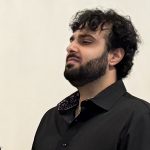Choral singing in the Nordic tradition
I know something you don’t know. I know what kulning is.
OK, OK, I’ll tell you.
Kulning is a piercing style of singing Scandinavians once used to call cattle or communicate over distance. Kulning found its way into folk songs, and at least one conservatory-trained Scandinavian composer picked it up.
I know all this because Saturday night I heard the Milwaukee Choral Artists sing Karin Rehnqvist’s I Himmelen (In Heaven’s Hall). Rehnqvist set a traditional poem about the joys of heaven. The spine of the piece is in fairly conventional polyphonic style. But very high outcries of kulnng melody erupted unpredictably from the spectacular voices of Alexa Doebele, Elizabeth Holterman and Christine Papania. They were distant from the other 11 women in Sharon Hansen’s superb choir and widely space around St. Matthew’s Lutheran Church. St. Matthew’s is an exaggerated cruciform building, in which sound surrounds you. It added to the image of drunken cherubs at a shrieking party up in the rafters while counterpoint was going on below. Wild.
The amazing I Himmelen was the high point and certainly the most original entry in a strong program comprising 18 numbers by a dozen composers. I could identify no schools or trends from this sample, but some influences were evident. Ola Gjeilo wrote Tundra in the melodramatic strain of cinematic Minimalism, with driving ostinatos and soaring lines above them, both couched in ominous minor modes. The Arvo Pärt influence in the chant-tinged sacred works of Frode Fjellheim and Jan Sandstrom was hard to miss.
Respect for heritage made soul mates of all these unlike composers. Fjellheim does for the yoik of the Sámi people of Scandinavia and Russia what Rehnqvist does for Swedish kulning. The Sámi try to capture an emotion in music alone, and thus sing in nonsense syllables so words don’t get in the way. His Night Yoik is a mood piece in that direction.
http://youtu.be/iebkm-3KfsE
Expert arrangements of folk songs and medieval melodies filled most of the second half. A Latvian song, arranged rather in the fashion of late organum by Jekab Grabins, gave choral artist Indra Brusubardis a particular chance to shine as a soloist. She did, with lovely clear tone and very subtle gradations between straight tone and vibrato.
But then, most of the singers had solo turns, and they all did very well. As always, music director Sharon Hansen had an opinion about every single note on the program, expressed it eloquently with her gestures, and her alert, eager, skilled singers made it real.






















